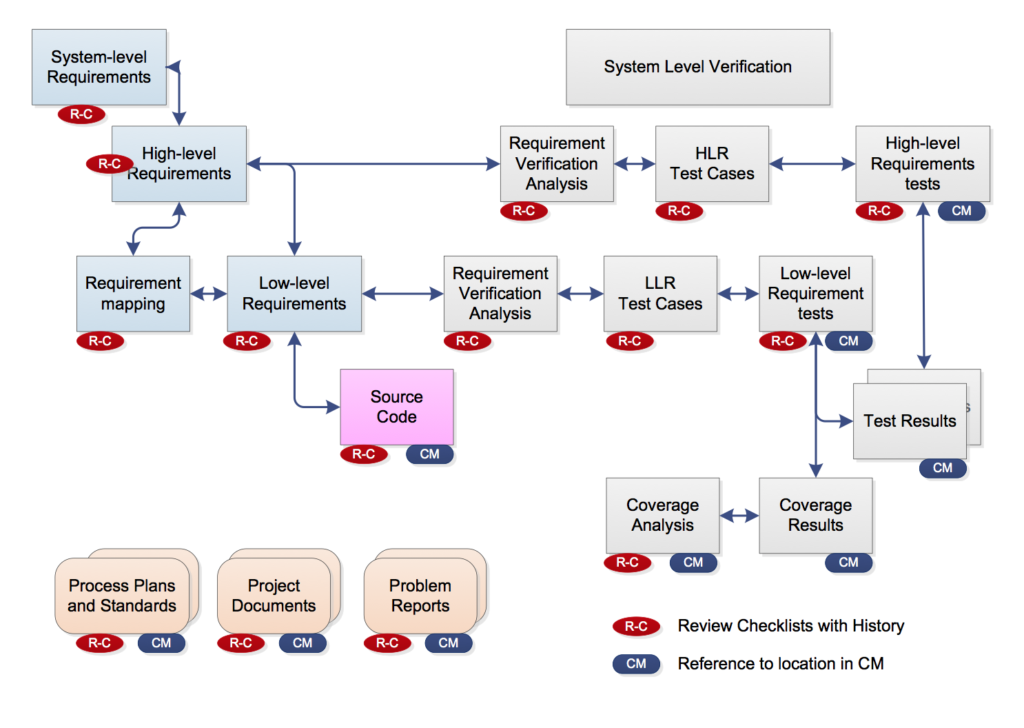Application Lifecycle Management with VeroTrace
VeroTrace
VeroTrace supports compliance with many certification standards such as DO-178C and more. Development teams can unify their software project within VeroTrace and integrate it with any configuration management system such as Git, CVS, SubVersion and more.
Features:
- Bi-directional trace of all requirements, design, and verification artifacts throughout the software development life cycle
- User controls and privileges – manage the state of all life cycle data items
- Integration with all COTS CM systems
- Quality Assurance controls and enforcement
- Problem Reporting and Tracking
- Automated completeness checking to ensure no missing data
- Change Impact Analysis capability identifies all areas affected by any modifications
- Document export and production capability
- Capture and review coverage analysis on all code down to the target level
- Export and generation of hyperlinked artifacts on electronic media image
Benefits:
- Lower costs: one investment for all projects
- Eliminate vendor and proprietary software lock-in
- Support for distributed development teams
- Reduce cost of compliance by centralizing all activities in one repository
- Minimize cost-of-change with qualified change impact analysis feature
Qualified for use with:
- DO-178B/C and DO-330, Level A (Aerospace)
VeroTrace reduces costs providing a single collaborative environment for distributed users.
VeroTrace is flexible and customers can choose their own CM system, test harness, coverage tools and problem reporting system.
Use only the features you need to control your project and comply with regulatory requirements. Best of all, VeroTrace can generate a complete hyperlinked electronic media image that shows complete traceability of all life cycle data so audits and assessments can be done off-site by providing auditors with all certification data in an easily browseable format.
Users can configure and store review checklists for each data item (requirements, code, etc.) and VeroTrace will manage the state of each item depending upon the outcome of a given review. Users define both high-level and low-level requirements in VeroTrace and then define the traceability relationships. At any time, VeroTrace can produce documents in an html format directly from the database. Review states and any review comments are maintained as part of the review logs. External linkages to a source code management repository (such as CVS) and test harness environments are fully supported so users can retain their existing infrastructure while migrating to VeroTrace.
How VeroTrace tracks and controls the relationships of software life cycle data.

Reporting
VeroTrace can generate a wide variety of reports that commonly describe the traceability and interrelationships between artifacts. The tool allows users to generate a variety of pre-defined reports based on the user-defined queries run against the project database.
Documents generated by VeroTrace include:
• System/Software Requirement Specifications
• Requirements Traceability Matrices
• Test procedure templates
• Life cycle phase status reports
• CM baseline reports
• and many more relationship-based documents…
Traceability and artifacts
VeroTrace combines XML traceability files (generated by VeroTrace and translated into hyperlinked HTML files) and the artifacts (requirements, designs, source, tests, tests results, review checklists) extracted from VeroTrace and its linked CM system.
The hyperlinked files point to each other to show the relationship between artifacts and their review evidence. VeroTrace also verifies the accuracy of the generated links (which can number in the tens of thousands) and the existence of the expected artifacts in their expected locations.
Changes to “approved” life cycle data
VeroTrace simplifies this effort and reduces human error with its built-in impact analysis function. Whenever the development state of an artifact is moved from “complete” to “incomplete” within the tool, the developer will be prompted to review a complete list of potentially impacted artifacts and determine which, if any, require update due to the change being made. This function provides a comprehensive impact analysis log maintained under the history of each artifact.
Regulatory compliance
VeroTrace will ensure compliance with the most rigorous CM objectives called out by DO-178 and DO-254. Moreover, VeroTrace supports a qualified “change impact analysis” process required for RTCA/DO-178C.

